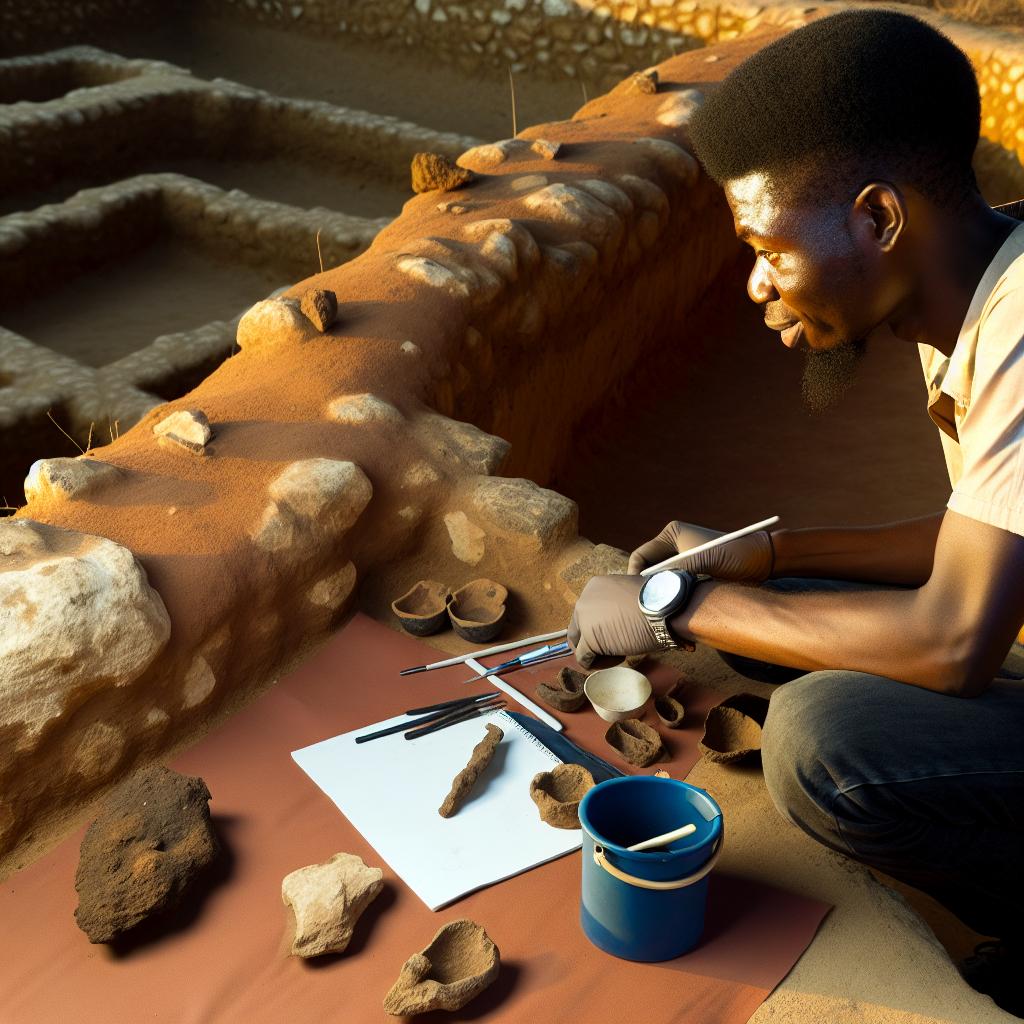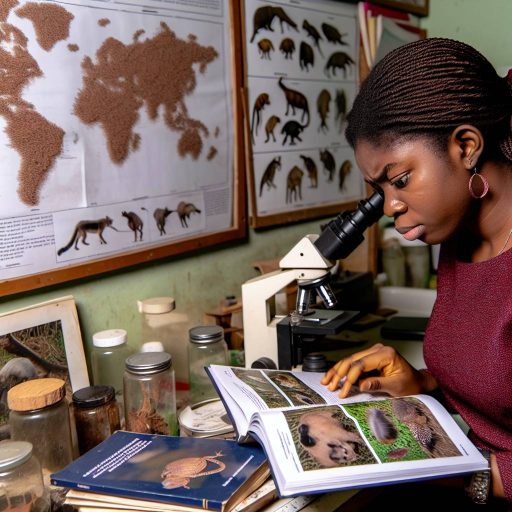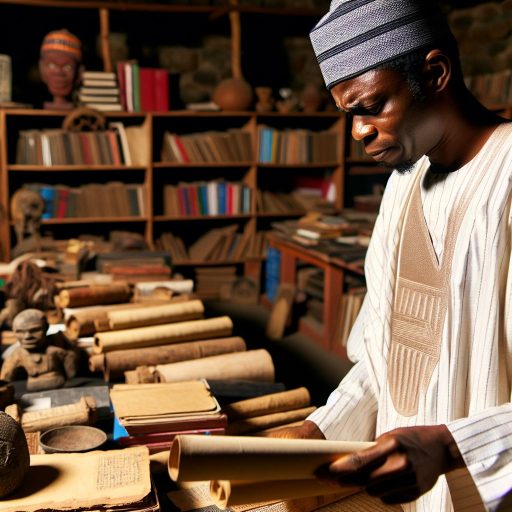Introduction:
In Nigeria, archaeological sites hold significant historical and cultural value.
These sites provide insights into the country’s rich past.
Climate change refers to the long-term alteration of temperature, precipitation, and weather patterns globally.
This alteration impacts various ecosystems.
Thesis Statement: Investigating the specific ways climate change adversely affects Nigerian archaeological sites.
Deterioration of Cultural Artifacts
Rising temperatures and extreme weather events can accelerate the degradation of ancient artifacts and structures.
Increased humidity levels due to climate change can lead to mold growth.
This growth causes irreversible damage to artifacts.
Sea Level Rise Threat to Coastal Sites
Coastal archaeological sites in Nigeria are at risk of being submerged.
Sea levels rise due to climate change.
The erosion of shorelines and flooding can destroy important historical sites.
This destruction impacts the country’s cultural heritage.
Loss of Biodiversity
Climate change affects the flora and fauna surrounding archaeological sites.
This disruption leads to loss of biodiversity.
Changes in plant and animal populations can disrupt ecosystem balance.
This disruption impacts the preservation of historical sites.
Impact on Indigenous Communities
Climate change poses a threat to indigenous communities near archaeological sites in Nigeria.
Environmental changes can affect their livelihoods and cultural practices.
Additionally, these changes impact their connection to ancestral lands.
Urgent Action Needed to Preserve Cultural Heritage
It is evident that climate change is significantly impacting Nigerian archaeological sites.
This situation jeopardizes the preservation of the country’s cultural heritage.
Efforts must be made to mitigate the effects of climate change.
We must protect these valuable sites for future generations to appreciate.
Vulnerability of archaeological sites to climate change:
Explanation of how Nigerian archaeological sites are susceptible to climate change:
- Due to their age and exposure, Nigerian archaeological sites are vulnerable to the effects of climate change.
- The degradation of materials like mud brick, rock, and ancient artifacts is accelerated by extreme weather events.
- Rising temperatures and unpredictable precipitation patterns can destabilize structures and erode ancient carvings.
- The shifting climate in Nigeria can lead to increased flooding, droughts, and intense storms that threaten site preservation.
Examples of specific sites at risk:
- The UNESCO World Heritage Site of Sukur Cultural Landscape is at risk due to increased rainfall and erosion.
- The Nok Archaeological Sites in central Nigeria are susceptible to flooding and soil erosion caused by heavy rains.
- The walls of Kano, a fortified city in Nigeria, are deteriorating due to increased humidity levels and heat.
- The ancient rock art of Birnin Kudu is fading due to exposure to harsh sunlight and changing climate patterns.
Discussion on the potential threats posed by climate change:
- Climate change poses a serious threat to the integrity and preservation of Nigerian archaeological sites.
- The increased frequency and intensity of extreme weather events can lead to rapid degradation and loss of cultural heritage.
- Temperature fluctuations and altered precipitation patterns can cause physical damage to structures and artifacts over time.
- Rising sea levels and coastal erosion may threaten sites located near water bodies or along the coastline.
Erosion and deterioration of artifacts:
Changing climatic conditions can accelerate the erosion and deterioration of archaeological artifacts.
- Heavy rainfall can wash away delicate artifacts buried underground.
- Increased humidity can cause organic materials to decay at a faster rate.
- Rising temperatures can cause structural damage to stone artifacts.
This erosion and deterioration do not only affect the physical appearance of artifacts but also impact the preservation of cultural heritage.
Archaeological sites in Nigeria are particularly vulnerable to erosion due to climate change.
- Kano City Walls in Kano State are facing erosion due to increased rainfall.
- Ife Bronze Works in Osun State are deteriorating due to high humidity levels.
- Sukur Cultural Landscape in Adamawa State is at risk of erosion from rising temperatures.
These case studies show the real and tangible impact of climate change on Nigerian archaeological sites, highlighting the urgent need for conservation efforts.
You Might Also Like: Challenges Facing Applied Zoology Education in Nigeria
Rising sea levels and coastal sites:
Climate change is leading to rising sea levels which poses a threat to coastal archaeological sites in Nigeria.
Coastal sites like Brass in the Niger Delta are at risk of inundation due to sea level rise.
The potential loss of archaeological evidence and cultural history is a major concern with rising sea levels.
Other sites like Oron, Lagos, and Bonny Island are also at risk of being submerged.
See Related Content: Ethnographic Studies: Key Nigerian Communities Explored
Changes in temperature and vegetation:
- Exploration of how shifts in temperature and vegetation patterns can affect the ecosystem surrounding archaeological sites
- Impact on the biodiversity of plant and animal species
- Consideration of potential implications for archaeological research and interpretation
When it comes to the impact of climate change on Nigerian archaeological sites, one of the key factors to consider is the changes in temperature and vegetation patterns.
These changes can have significant effects on the surrounding ecosystem and ultimately impact the preservation and interpretation of these historical sites.
Exploration of how shifts in temperature and vegetation patterns can affect the ecosystem surrounding archaeological sites:
The Nigerian climate is characterized by distinct wet and dry seasons, with variations in temperature and rainfall patterns.
As a result of climate change, these patterns are becoming increasingly unpredictable, leading to shifts in vegetation distribution and density around archaeological sites.
Transform Your Career with Expert Guidance
Get personalized mentorship consulting that’s tailored to your unique path. Our expert advice is actionable and exclusive.
Get StartedThese shifts can alter the ecological balance of the surrounding areas, affecting the availability of resources for both plant and animal species.
This, in turn, can impact the overall biodiversity of the region and potentially disrupt the delicate ecosystem that supports these archaeological sites.
Impact on the biodiversity of plant and animal species:
As temperature and vegetation patterns change, certain plant and animal species may struggle to adapt to these new conditions.
This can lead to shifts in species composition and distribution, with some species thriving while others decline or disappear altogether.
For archaeological sites that rely on specific plant species for preservation or interpretation, these changes in biodiversity can have a direct impact on the site’s historical significance.
Researchers may find it increasingly challenging to accurately understand the environment in which these sites existed, making it difficult to draw meaningful conclusions about the past.
Consideration of potential implications for archaeological research and interpretation:
The implications of climate change on Nigerian archaeological sites go beyond just ecological shifts – they also extend to the practice of archaeology itself.
As the surrounding environment changes, researchers must adapt their methods and interpretations to account for these shifts.
One potential implication is the need for interdisciplinary collaboration between archaeologists and climate scientists to better understand and mitigate the impact of climate change on these sites.
By working together, experts from different fields can develop innovative approaches to archaeological research that take into account the changing environmental conditions.
Gain More Insights: Marine Biology: Nigerian Coastal Pollution Issues
Mitigation and Adaptation Strategies:
Climate change poses a significant threat to Nigerian archaeological sites.
Nonetheless, there are strategies that can help mitigate its impact.
These strategies ensure the preservation of these valuable heritage sites.
Overview of Potential Strategies to Mitigate the Impact of Climate Change on Nigerian Archaeological Sites:
- Implementing effective drainage systems to prevent erosion and flooding.
- Using sustainable materials and construction techniques in site maintenance and restoration.
- Developing monitoring programs to track climate-related changes and assess site vulnerability.
- Engaging local communities in conservation efforts to raise awareness and promote stewardship.
Discussion on the Importance of Sustainable Conservation Practices:
Sustainable conservation practices are essential for the long-term protection of archaeological sites in Nigeria.
They prioritize environmental sustainability and cultural heritage preservation.
These practices help mitigate the negative effects of climate change on archaeological sites.
Additionally, they promote community involvement.
Sustainable practices ensure that future generations can continue to enjoy and learn from these important cultural resources.
Examples of Successful Adaptation Measures Implemented at Archaeological Sites Globally:
- The use of vegetative cover and soil conservation techniques to prevent erosion at Mesa Verde National Park in the United States.
- The installation of protective shelters over rock art sites in Australia to shield them from the effects of climate change.
- The development of climate-responsive site management plans at Machu Picchu in Peru to minimize the impact of extreme weather events.
- The adoption of sustainable tourism practices at Angkor Wat in Cambodia to reduce visitor impact on the site and surrounding environment.
By learning from successful adaptation measures implemented at archaeological sites around the world, Nigeria can develop its strategies.
These strategies will protect its rich cultural heritage from the threats of climate change.
Through a combination of mitigation and adaptation efforts, Nigerian archaeological sites can continue to be preserved.
This will allow future generations to explore and appreciate them.
Discover More: Microbiology Lab Safety Protocols in Nigeria

Collaborative Efforts and Interdisciplinary Research
Collaborative efforts in addressing the impact of climate change on Nigerian archaeological sites are crucial.
By combining the expertise of archaeologists, climate scientists, and local communities, we can develop innovative solutions to protect our heritage.
Importance of Interdisciplinary Collaboration
Archaeologists bring historical context to the table, while climate scientists provide data on environmental changes.
Local communities offer valuable insights and traditional knowledge about the sites.
By working together, these diverse perspectives can lead to a more holistic understanding of the challenges posed by climate change.
Case Studies of Successful Partnerships
One example of successful collaboration is the partnership between archaeologists from Nigerian universities and international climate scientists.
Together, they conducted research on the impact of rising sea levels on coastal sites in Nigeria.
Their findings led to the development of adaptation strategies to protect these vulnerable sites.
Another case study involves the active involvement of local communities in the preservation of archaeological sites.
By engaging community members in site management and conservation efforts, these partnerships have enhanced the protection of cultural heritage in Nigeria.
Discussion on the Need for Diverse Perspectives
Protecting Nigerian archaeological sites from the effects of climate change requires diverse perspectives and expertise.
Each discipline brings a unique set of skills and knowledge to the table, allowing for a more comprehensive approach to conservation efforts.
Archaeologists offer insights into the historical significance of the sites, while climate scientists provide data on environmental threats.
Local communities contribute traditional knowledge and help implement conservation strategies that are culturally sensitive and sustainable.
By fostering interdisciplinary collaboration and embracing diverse perspectives, we can ensure the long-term preservation of Nigeria’s rich archaeological heritage in the face of climate change challenges.
Advocacy and awareness-raising:
- Importance of raising awareness about the impact of climate change on Nigerian archaeological sites
- Role of advocacy in promoting sustainable conservation practices
- Strategies for engaging local communities and stakeholders in preserving cultural heritage in the face of climate change
Importance of raising awareness about the impact of climate change on Nigerian archaeological sites
Raising awareness is crucial in garnering support for the preservation of Nigeria’s archaeological sites.
The general public must understand the threats posed by climate change to these sites.
Educational campaigns can highlight the cultural significance of these sites and the need for conservation efforts.
Increased awareness can lead to increased funding for research and conservation projects.
Local and international communities may be more willing to collaborate on preservation efforts.
Role of advocacy in promoting sustainable conservation practices
Advocacy plays a key role in advocating for policies that promote sustainable conservation practices.
Advocates can lobby for legislation that protects archaeological sites from the impacts of climate change.
They can also push for funding to support conservation efforts and research into climate change impacts.
Advocates raise public awareness and mobilize support for preserving Nigeria’s cultural heritage.
Advocacy can influence decision-makers to prioritize the conservation of archaeological sites.
Strategies for engaging local communities and stakeholders in preserving cultural heritage in the face of climate change
Engaging local communities is essential for the long-term preservation of archaeological sites in Nigeria.
Community involvement fosters a sense of ownership and responsibility for cultural heritage.
Stakeholders, including government agencies, NGOs, and academics, must work together to protect these sites.
Education programs can empower communities to actively participate in conservation efforts.
Involving stakeholders in decision-making processes ensures diverse perspectives are considered.
Nigerian Archaeological Sites and Climate Change
The archaeological sites in Nigeria are facing severe threats due to climate change.
It is imperative to take immediate action to safeguard these sites.
We must preserve our cultural heritage for future generations.
Continued research and conservation efforts are crucial.
Advocacy is essential to protect Nigerian archaeological sites.
We must work together to raise awareness of these challenges.
Implementing measures can mitigate the impact of climate change on these sites.
Let us act now to secure the legacy of our ancestors.
Our history deserves to be preserved for generations to come.
Additional Resources
Climate Change Threatens Africa’s Cultural Heritage – Union of …
The Impact of Climate Change on Meningitis in Northwest Nigeria …




